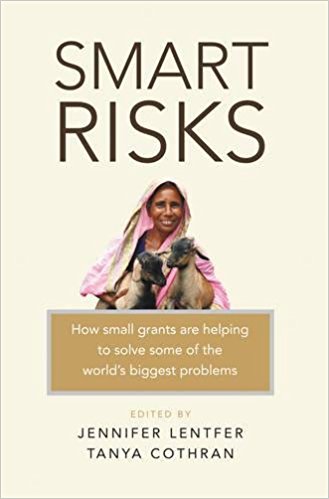
Book Review: What Makes a Risk a “Smart Risk”?
How can funders make small yet informed risks that can help advance progress on an international level? Jennifer Lentfer and Tanya Cothran explore this question in Smart Risks, a collection of case studies, personal experiences, and analyses from 22 small international grantmakers whose organizations collectively have awarded approximately 12,000 grants and a total of $130 million over the past 30 years. Their aim is to encourage donors and funders—both small and large—to see the value in what is essentially trust-based philanthropy.
Smart Risks’ underlying theme is that communities most impacted by socioeconomic and environmental problems should play a key role devising solutions to those problems. While not necessarily new, this message is more important than ever for folks within philanthropy to hear—especially given the prescriptive, top-down lens through which many funders view their grantmaking. Smart Risks makes a compelling case that there is real value in a more grassroots approach, one that acknowledges and supports the expertise and leadership within the communities funders want to help.
“Smart risks start ‘where people are’ and support the local processes that build upon communities unique strengths, resources, and ideas.”
The book is written in a practical, accessible way, with five major sections that highlight different strategies for making smart risks. Each section includes short but powerful 2-4 page essays from various contributors, including 3-point summaries at the end of each section and text boxes with reflection prompts. This layout makes it easy for the reader to scan the book to find sections that are most relevant and resonant, with additional resources and links that allow you to dig deeper as you go.
In their introduction, Lentfer and Cothran highlight the book’s fundamental premise: the smart risk each author made was to trust local leadership. “Circumventing the default strategy means not having outsiders or Westerners determine what’s right for others. They let go of control and resist the urges that lead to overbearing oversight. Rather than funding projects that they conceive and control, they learn directly from community leaders who are social innovators in their own context, and fund their initiatives and ideas.” In many ways, investing in local expertise is about being non-prescriptive, flexible, and taking a long-range view—which of course translates into one of the major pillars of trust-based philanthropy: multi-year unrestricted funding.
A key section of the book invites readers to look to the grassroots for innovation. Caroline Mailloux writes, “Often what is considered ‘innovative’ in global development is what’s new, the latest idea or product as in the private sector. But what if innovative simply meant including previously excluded people in decision making and accountability mechanisms? What if innovation were found in the individual reflection processes that people use to identify and overcome obstacles, resulting in changes or adaptations to people’s work on the ground?”
Her questions definitely resonate with TWI’s values of dialogue, relationships, and inclusion. And by inviting funders and donors to rethink their understanding of innovation, the authors are explicit that how you engage, how you do your grantmaking matters. These are the innovative actions we should be exploring in philanthropy.
“Taking smart risks requires a balance of due diligence, trust, and long-term perspective, as well as humility and honesty with oneself.”
The final section of the book leads to the more personal aspects of taking smart risks. Namely, practicing vulnerability as a funder—a vulnerability that opens us up to listening with humility, empathy, and curiosity. When we engage in this way, trusting, authentic relationships become possible—to the ultimate benefit of our collective work and aspirations. These ideas build toward the book’s conclusion, which features a five-point manifesto for grassroots leadership, including concepts like “lead by following” and “build trust like it’s your job … because it is.”
It’s really encouraging to see a publication dedicated to so many trust-based grantmaking concepts, and I can see it being a useful resource for individual donors, as well as foundation staff and boards. The assembled wisdom and experience the book brings together is compelling. I am biased of course, but I think even skeptics encountering this book might well find themselves questioning their assumptions about change, innovation, and expertise. Not to mention the catalytic and effective role small, grassroots grants can play in communities.
I had the pleasure of recently attending the Bay Area book launch for Smart Risks. What struck me that evening was the humble, gracious way the authors held themselves and the gratitude they expressed to each other. Which reminded me of the book’s implicit theme of not just approaching grantmaking as a matter of strategy or technical steps, but of actually embodying the values underlying the strategy and implementation.
The way the event was structured—which included several of the authors reading brief passages from the book—perfectly embodied the ideas in the book. After each short reading, they provided prompting questions for the audience to discuss in pairs, and encouraged us to find a new discussion partner for each prompt. They wanted us to engage each other in a spirit of listening, learning, and generosity. They wanted us to think together. They wanted to build connection and relationships.
Engaging in that way is a risk hopefully more and more funders—both international and domestic—will be willing to take. Reading this book is definitely one place to start.